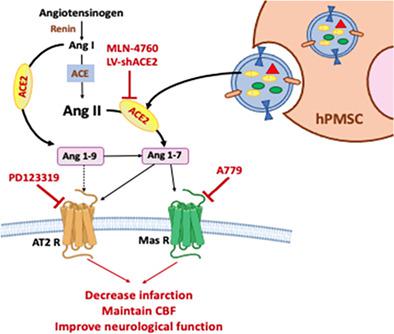当前位置:
X-MOL 学术
›
STEM CELLS
›
论文详情
Our official English website, www.x-mol.net, welcomes your feedback! (Note: you will need to create a separate account there.)
Human placenta mesenchymal stem cell protection in ischemic stroke is angiotensin converting enzyme-2 and masR receptor-dependent
STEM CELLS ( IF 5.2 ) Pub Date : 2021-06-14 , DOI: 10.1002/stem.3426 Mansoureh Barzegar 1 , Shantel Vital 1 , Karen Y Stokes 1 , Yuping Wang 2 , Jungmi Winny Yun 1 , Luke A White 1 , Oleg Chernyshev 3 , Roger E Kelley 3 , Jonathan S Alexander 1, 3
STEM CELLS ( IF 5.2 ) Pub Date : 2021-06-14 , DOI: 10.1002/stem.3426 Mansoureh Barzegar 1 , Shantel Vital 1 , Karen Y Stokes 1 , Yuping Wang 2 , Jungmi Winny Yun 1 , Luke A White 1 , Oleg Chernyshev 3 , Roger E Kelley 3 , Jonathan S Alexander 1, 3
Affiliation

|
Thromboembolic stroke remains a major cause of neurological disability and death. Current stroke treatments (aspirin, tissue plasminogen activator) are significantly limited by timing and risks for hemorrhage which have driven researchers to explore other approaches. Stem cell-based therapy appears to be an effective option for ischemic stroke. Besides trans-differentiation into neural cells, stem cells also provide acute protection via paracrine signaling pathways through which releasing neuroprotective factors. We previously reported that intraperitoneal administration of human placenta mesenchymal stem cell (hPMSC) therapy upon reperfusion significantly protected the brain against middle cerebral artery occlusion (MCAO)-induced injury. In the present study, we specifically investigated the role of hPMSC-derived angiotensin converting enzyme-2 (ACE-2) in protection of MCAO-induced brain injury by measurement of brain tissue viability, cerebral blood flow, and neurological score. Here, we report for the first time that hPMSC expressing substantial amount of ACE-2, which mediates hPMSC protection in the MCAO model. Strikingly, we found that the protective effects of hPMSC in MCAO-induced brain injury could be attenuated by pretreatment of hPMSCs with MLN-4760, a specific inhibitor of ACE-2 activity, or by transfection of hPMSCs with ACE-2-shRNA-lentivirus. The hPMSC-derived ACE-2 specific protective mechanism was further demonstrated by administration of PD123319, an Angiotensin type-2 receptor antagonist, or A779, a MasR antagonist. Importantly, our study demonstrated that the protective effects of hPMSC in experimental stroke are ACE-2/MasR dependent and this signaling pathway represents an innovative and highly promising approach for targeted stroke therapy.
中文翻译:

缺血性卒中中人胎盘间充质干细胞的保护是血管紧张素转换酶 2 和 masR 受体依赖性的
血栓栓塞性中风仍然是导致神经功能障碍和死亡的主要原因。目前的中风治疗(阿司匹林、组织纤溶酶原激活剂)受到出血时间和风险的显着限制,这促使研究人员探索其他方法。基于干细胞的治疗似乎是缺血性中风的有效选择。除了转分化成神经细胞外,干细胞还通过旁分泌信号通路释放神经保护因子提供急性保护。我们之前报道过,在再灌注时腹腔内给予人胎盘间充质干细胞 (hPMSC) 治疗可显着保护大脑免受大脑中动脉闭塞 (MCAO) 引起的损伤。在目前的研究中,我们通过测量脑组织活力、脑血流和神经系统评分,专门研究了 hPMSC 衍生的血管紧张素转化酶 2 (ACE-2) 在保护 MCAO 诱导的脑损伤中的作用。在这里,我们首次报道了表达大量 ACE-2 的 hPMSC,其在 MCAO 模型中介导 hPMSC 保护。引人注目的是,我们发现通过用 ACE-2 活性的特异性抑制剂 MLN-4760 预处理 hPMSCs 或用 ACE-2-shRNA-慢病毒转染 hPMSCs 可以减弱 hPMSCs 在 MCAO 诱导的脑损伤中的保护作用。 . 通过使用 PD123319(一种 2 型血管紧张素受体拮抗剂)或 A779(一种 MasR 拮抗剂)进一步证明了 hPMSC 衍生的 ACE-2 特异性保护机制。重要的,
更新日期:2021-06-14
中文翻译:

缺血性卒中中人胎盘间充质干细胞的保护是血管紧张素转换酶 2 和 masR 受体依赖性的
血栓栓塞性中风仍然是导致神经功能障碍和死亡的主要原因。目前的中风治疗(阿司匹林、组织纤溶酶原激活剂)受到出血时间和风险的显着限制,这促使研究人员探索其他方法。基于干细胞的治疗似乎是缺血性中风的有效选择。除了转分化成神经细胞外,干细胞还通过旁分泌信号通路释放神经保护因子提供急性保护。我们之前报道过,在再灌注时腹腔内给予人胎盘间充质干细胞 (hPMSC) 治疗可显着保护大脑免受大脑中动脉闭塞 (MCAO) 引起的损伤。在目前的研究中,我们通过测量脑组织活力、脑血流和神经系统评分,专门研究了 hPMSC 衍生的血管紧张素转化酶 2 (ACE-2) 在保护 MCAO 诱导的脑损伤中的作用。在这里,我们首次报道了表达大量 ACE-2 的 hPMSC,其在 MCAO 模型中介导 hPMSC 保护。引人注目的是,我们发现通过用 ACE-2 活性的特异性抑制剂 MLN-4760 预处理 hPMSCs 或用 ACE-2-shRNA-慢病毒转染 hPMSCs 可以减弱 hPMSCs 在 MCAO 诱导的脑损伤中的保护作用。 . 通过使用 PD123319(一种 2 型血管紧张素受体拮抗剂)或 A779(一种 MasR 拮抗剂)进一步证明了 hPMSC 衍生的 ACE-2 特异性保护机制。重要的,



























 京公网安备 11010802027423号
京公网安备 11010802027423号